
Wine Corks 101: The Types Of Cork, Where They Come From, and More


Do you know your wine corks? When you're enjoying a nice glass of fine wine, do you ever wonder why a bottle of wine needs a cork and where it might originate? Probably not. I bet you didn't know that there's a lot more to wine corks than just keeping the wine in the bottle.
This blog post will give you a deeper look at wine corks and help you learn more about how they are made and where they come from. So pull up a chair, pour yourself a glass of your favorite wine, and join us as we explore the world of wine corks!

The wine cork is symbolic of preservation, not only for the wine in the bottle but also as a way of life for cork farmers and the forest's natural environment. The procedure has remained unchanged for decades since the setup is a sustainable chain that benefits the local economy, nature, and the cork-using industries, especially the wine industry.
For over 400 years, cork has been utilized as a bottle stopper. Because it includes a natural waxy substance called suberin, it may be the ideal material for use as a bottle stopper. It also possesses qualities not present in any other naturally occurring substance.
It is lightweight, rot-resistant, fire-resistant, termite resistant, gas and liquid impermeable, soft, and buoyant. Because of these characteristics, it is great for wine bottles and even tile flooring.

Wine corks are the most important component of a wine bottle. They have been around for thousands of years, and they've served as an effective barrier to wine for centuries.
Wine corks are typically made from either synthetic or organic materials, namely cork oak tree and polyethylene, and come in different shapes and sizes.
Below are the different types of wine corks:

Natural corks are the most common and popular type of cork used in wine bottles because of their superior sealing ability. They are obtained from the bark of cork oak trees.
Natural corks are generally made from the new outer sheath portion of the bark after the original layer is removed and then compressed into blocks of different sizes.
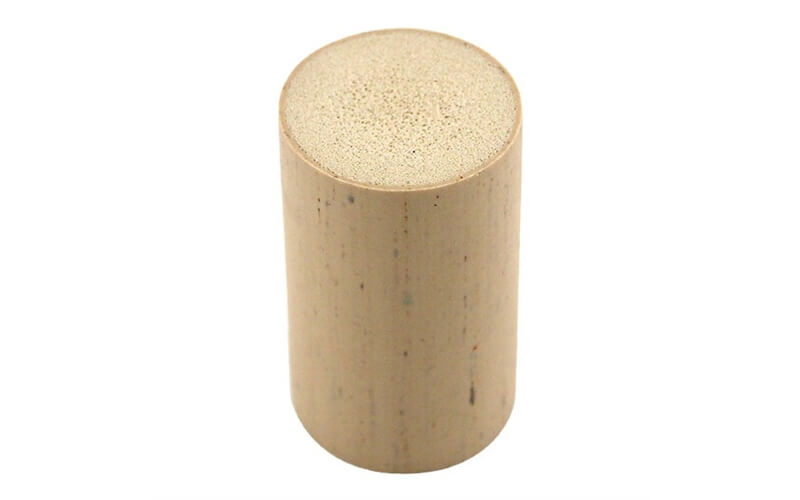
Synthetic corks have been used for many years to replace the natural cork. Made of synthetic resin, they take on the desired shape and then dry before being cured! Synthetic resin corks are a lighter alternative to natural cork, but they have the disadvantage of being less durable.
One of the benefits of synthetic corks is that it minimizes the risk of cork taint. Cork taint is an off-flavor in wine and is caused by the chemical compound 2,4,6-trichloroanisole (TCA), which is found naturally in cork oaks.

Unlike traditional corks, Champagne corks are designed to be more elastic and disc-like at the bottom part of the cork. When carbon dioxide combines with a certain amount of pressure, they expand and forms into a mushroom-shaped cork that is familiar to us today.

Capped corks give you the best of both worlds, with a part of them that is firm enough to seal the bottle firmly in place (the outer cap) and a part that is soft enough to be easily popped out (the inner cork).
The outer cap is made from plastic and is attached to the cork by a strong adhesive. The main benefit of this type of wine stopper is that the cork is sealed and protected from the elements by the outer cap, so it will not dry out, rot, or lose any of its resiliency.

Helix corks are made from the same natural resin as cork stoppers for wine bottles. These corks can be reused and used to seal any wine bottle with a spiral-patterned bottleneck. Helix corks have been designed to make corks easier to remove from their packaging.

Grainy corks are inexpensive alternatives that help maintain freshness while also improving the aesthetics of your packaging. Agglomerate corks are made by processing wood fibers into small particles and then combining them with the residual cork granulates from natural corks.

Tasting corks are natural corks with plastic tops. They’re perfect for short-term wine storage. They're easy to use and can be found at most local wine stores, grocery stores, or online retailers.
Tasting corks are cheap, and they're great for all types of wine (red, white, rose, sparkling). If you have wine bottles lying around without corks, give them a try!

When you open a bottle of wine, it expands and pushes up against the cork. This is fine for many types of wine but not for sparkling wine. To remedy this, some people will add a rubber stopper to the top of the bottle.
Hermetic corks offer a simple and effective way to seal your wine bottles. They come in different materials, including metal or plastic with an addition of wood for added dimensionality on some designs-and even silicone!

A screw cap is a metal disc with threads around its perimeter. Screw caps are used in wine bottles because they are more effective in preventing oxygen from entering the bottle. Screw caps are preferred over natural cork because they are easier to use and are more reliable.

A vinoseal or vinolok is a type of wine closure made of glass and has a gasket that goes around the bottom part of the cap that is locked tight when engaged with the lip of the bottle.
These closures are much more expensive than the traditional cork, but they are also more elegant. They provide an airtight seal and prevent oxidation for longer periods.

A zork is a type of wine closure with a foil joined together between the cap and the cork. The foil seals the cork in place and keeps it from shifting. This prevents oxidation and makes your wine taste fresh longer.

Crown caps are usually found on bottled beers and sodas but don’t ring a bell with wine. However, the idea of adding a crown cap to a wine bottle is certainly not a new one. In fact, there are wine bottles (especially sparkling wine bottles) with crown caps, and they’ve been around for decades.
Crown caps are used to keep the bottle's contents safe and prevent it from being tampered with. They are not reusable, so it’s much better to stick with standard corks.

A wine closure keeps out air until you’re ready to drink the wine, and then it seals the bottle so that no more oxygen enters the bottle. You risk your wine spoiling if you don’t use a proper wine closure.
Oxygen in wine is not that all bad. In fact, it helps some wines reach their maximum potential. However, in general, oxygen is not good for wine as it oxidizes the alcohol and can also turn it into vinegar.
Wine closures can be found in several different materials, including plastic, glass, metal, and wood. This section will look at the four major types of closures.

The most common type of wine bottle closure is the natural cork. Natural corks are derived from the bark of a particular species of an oak tree, Quercus suber, which is native to the Western Mediterranean region.
Natural corks are made of desquamated cells that have gradually accumulated in the outer layer of the bark of the cork oak tree, Quercus suber, which is native to the Western Mediterranean region.
These dead cells are then cleansed and soaked in a chemical treatment before they are molded and compressed into different cork sizes.
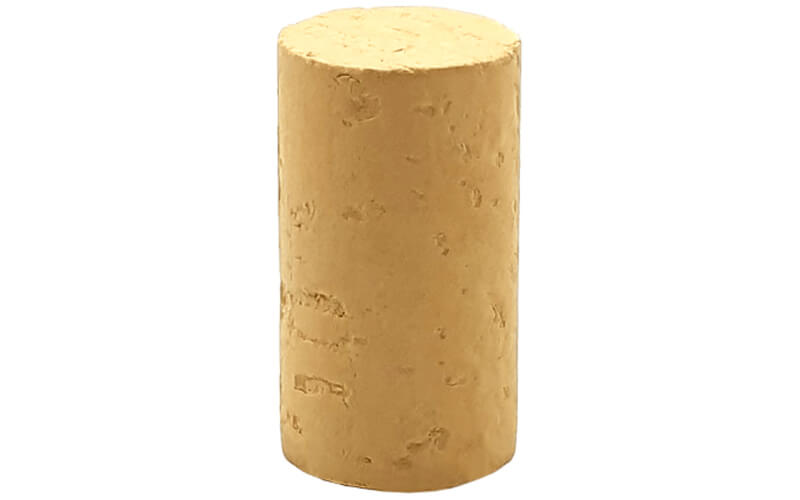
Colmated cork closures are basically natural corks that are processed to provide a more reliable seal than natural corks by compressing the lenticels (tiny pores you see on natural corks) with powdered oak using a strong, industry-grade binding agent.
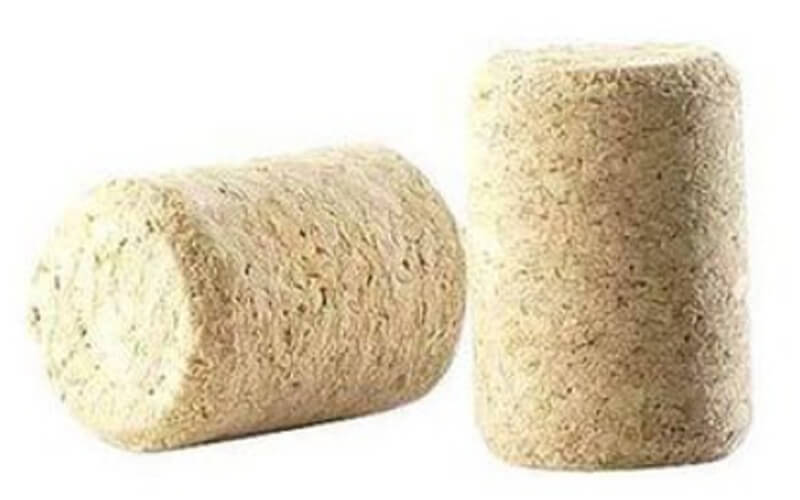
Agglomerated cork closures are made from a mass of granular or powdered corks. These closures are formed by a method that includes the following steps: mixing cork granulates and an adhesive to form a mixture, forming blocks of the mixture, and molding cork agglomerates.
Agglomerated corks are so tightly held together that no oxygen can get in and spoil the wine. But once opened, wine must be kept in a dark place and at least at room temperature to keep it from oxidizing.

One distinct characteristic of technical corks is that they have an agglomerated corks' body and a prominent disk or disks on one or both ends. The result is a closure that is less permeable than natural corks but resilient at the same time.
This means that technical cork closures have better resistance against the attack of wine components such as oxygen and alcohol and the ability to maintain their shape under pressure exerted by the liquid contained in the bottle.

Cork bottle stoppers dating back millennia ago have been discovered in Egyptian tombs. Corks were utilized by the Greeks to construct fishing net floats, sandals, and bottle stoppers. The Romans widely used it 2000 years ago in several applications, including life jackets for fishermen.
Cork roofs have been used in Mediterranean cottages for hundreds of years to block summer heat and winter cold. As a flooring material, it offers a pleasant walking surface.
Glass bottles were created in the fourteenth century, but their widespread usage did not occur until the seventeenth century. The use of cork as a stopper led to the intentional cultivation of cork trees instead of simply harvesting cork wherever it grew.
In 1892, the innovative crown cap—a metal cover coated with a disk of natural cork often referred to as a bottle cap—was produced.
Until about 1890, a large portion of the cork harvest was wasted. However, waste was reduced when a German corporation discovered a technology for adding a clay binder to cork particles and generating agglomerated cork sheets for insulation.
The following year, an American called John Smith invented a method for manufacturing pure-cork agglomeration from cork waste by subjecting cork particles to heat and pressure without the need of a binder. The next significant breakthrough happened in 1909 when Charles McManus produced a sort of agglomerated cork that could possibly be used to line crown caps.
Many alternative processes have now been devised to generate cork compounds with a wide range of characteristics and applications.
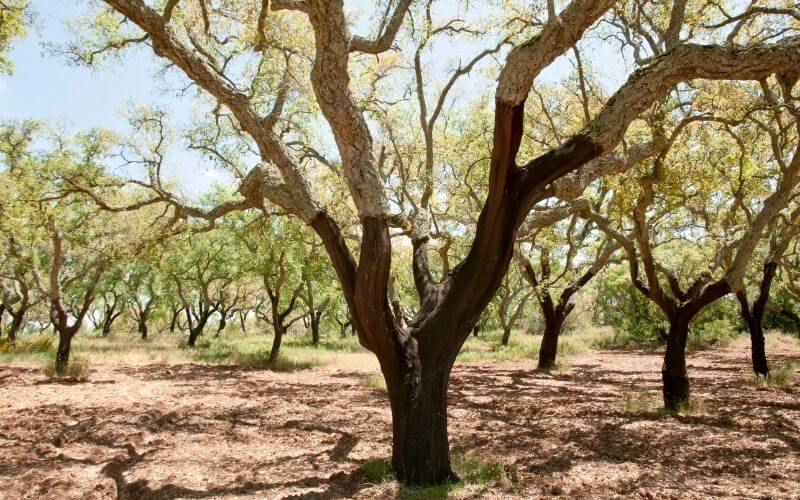
Almost every tree contains an outer layer of cork bark. Still, the cork oak tree (Quercus Suber) is the primary source of most cork items worldwide, notably wine bottle stoppers.
Cork grows naturally in just two places on the planet: Northwest Africa and the Mediterranean region of Europe, where there is lots of sunlight, little rain, and high humidity. More specifically, in the Iberian Peninsula, where Spain and Portugal produce over 80% of the world's cork.
So, what accounts for the cork oak's more significant layer of cork bark compared to other trees? The tree evolved and developed to protect itself from the severe environment of the Mediterranean woodland.
Droughts, brush fires, and temperature variations are common in these areas. The cork is formed of water-resistant fibers that divide the tough outer bark from the delicate inner bark.

Montado is a word in Portuguese that describes a landscape with a specific type of ecosystem. In Spanish, it is called Dehesa. It is made up of fields for farming, forestry, and herding, as well as extensive oak woodlands in between. It has been carefully planned and developed for thousands of years to ensure that the land will be productive for several years to come.
Species of the genus Quercus are littered across the montado. Although there are considerable tracts of holm oak (Quercus rotundifolia) and some minor sections of Pyrenean oak (Quercus pyrenaica), cork oaks (Quercus Suber L) make up the majority of the montado.
Los Alcornocales Natural Park (meaning "the cork oak grove") is the most extensive stretch of cork oak on the Iberian Peninsula. The cork woodlands are a habitat to a diverse range of wildlife, notably endangered species like the Iberian lynx, Iberian imperial eagle, and other exotic birds.
These woods are home to a gorgeous variety of ferns, mushrooms, and other flora. They also have cork oak trees, which may grow up to 65 feet tall and offer shelter for the critters that flourish here.
The term "harvest" is often a threat to most forest ecosystems. However, a cork harvest is not typical of forestry because the tree is not cut down. In fact, the tree is not harmed due to the cork oak's remarkable capacity to regenerate outer bark (the cork) and the farmers' expertise.
There is no deforestation, heavy machinery, or industrial complex—only a sustainable way of life that preserves nature's treasure.

The cork tree should only be harvested by qualified people called extractors, who will guarantee that the procedure does not harm or damage the tree and uses traditional methods that are still in use today.
Harvesting should only be done between the end of May, the beginning of June, and the end of August when the cells essential for its production remain active and continue to divide.
Cork may be harvested from the tree without harming it under these conditions. Additionally, this is only achievable if water is present in the plant.
The bigger the planks removed, the higher their market value. Thus, they are carefully removed to prevent breaking. The tree is identified by the last digit of the year in which it was harvested. For example, trees harvested in 2014 were labeled with a 4.
A cork oak may be harvested around 15 times during its lifespan. However, the tree may only be harvested for the first time when it is 25 years old and reaches a trunk circumference of 2.3 feet.
The first harvest, known as "desboia," yields a highly uneven cork that is very difficult to handle. Because this cork does not match the quality standards for cork stoppers, it will be utilized for other purposes like flooring, insulation, etc. It is referred to as virgin cork.
The second harvest occurs nine years later. However, the material produced is still unsuitable for cork stoppers, despite being considerably softer and having a more consistent form than the virgin cork. We refer to this second harvest as secondary cork.
Only the third and following harvests will provide cork that fulfills the required standards for cork stoppers, as its structure has now become regular, with a smooth outside and inside.
From this point on, the cork oak will provide an average of 45 kilos of high-quality cork every nine years, enough to produce 3000 cork stoppers. This cork is known as "amadia cork."
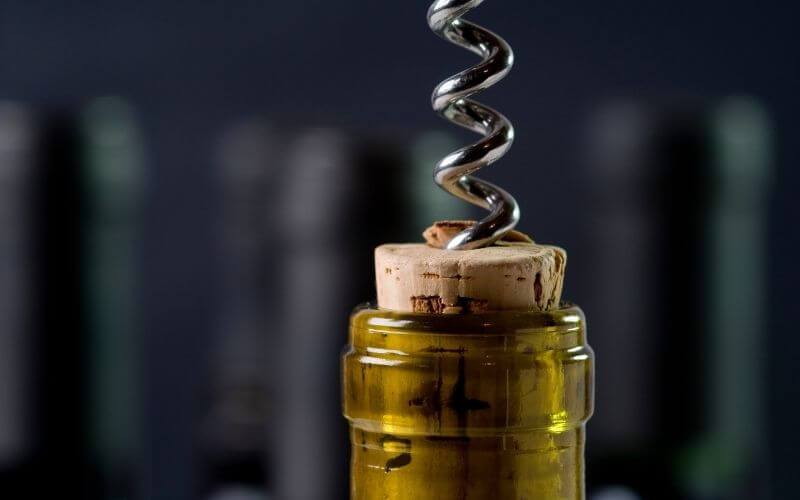
Corks protect the wine in the bottle, significantly slowing the oxidation process and helping the wine age and develop gradually over time.
This occurs because corks, or more specifically, excellent corks, let just a tiny quantity of oxygen into the wine. This is significant because when air interacts with the wine, the wine ultimately oxidizes. As previously said, just a small quantity of air should interact with the wine since this is how wines acquire their mature, secondary aspects and remove undesirable scents.
The highest quality corks allow around 3.5 ounces of oxygen to penetrate the bottle each year. This is just enough air to eliminate the sulfites added during the bottling stage to keep the wine fresh and avoid the negative impacts of oxidation.
This modest amount of air is ideal for assisting age-worthy wines in developing their nuances as the tannins soften.
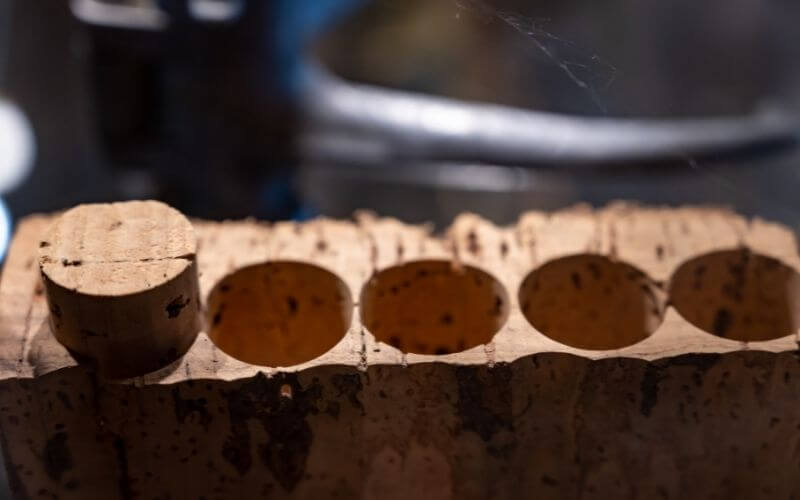
The harvester slashes through the cork layer on the tree's trunk with a specially designed hatchet, being immensely careful not to cut too deeply and harm the live section of the trunk.
Horizontal cuts are done around the trunk's base and slightly below the lowest branches.
A few vertical incisions divide the circumferential cork ring into appropriate-sized parts. The harvester removes each cork panel from the tree using the hatchet's wedge-shaped handle. Cork is also removed off the lower branches of certain giant trees.
The cork boards are placed outside and left to cure for a few weeks up to 6 months. Competent cork manufacturers will keep them on concrete instead of bare earth, reducing the chance of contamination. The fresh air, sunlight, and rain promote chemical changes that raise the cork's quality.
The boards had then flattened out and lost around 20% of their initial moisture content by the conclusion of the curing period. Flatter barks mean that they will be easier to work with. Some barks are pretty thin and will not be utilized to make high-quality natural corks.
But today, there are technical corks, which are formed of little bits of cork welded together, which ensures that more of the cork bark may be utilized to make wine bottle stoppers.
Next, the boards are treated with heat and water to eliminate dirt and water-soluble substances like tannin and soften and stretch the cork. Stacks of cork boards are often lowered into large copper vats filled with boiling water and fungicide. Heavyweights are laid on top to keep the cork underwater for 30 to 75 minutes.
In the poor old days, corks were cooked in muddy pits with little to no water change. To eliminate cross-contamination, regular cleaning, filtering, and replacing of water is now an essential part of the process. Also, volatiles are removed continuously.
When the planks are taken from the vat, a hoe-shaped tool is used to peel off the poor-quality external layer of cork. This accounts for around 2% of the volume but 20% of the weight of the plank. The boards are placed in a dark cellar to dry and cure under controlled humidity for a few weeks.
The cork boards are cut to a consistent, rectangular shape and graded. Natural cork products such as wine bottle stoppers will be made from the highest quality material. Poorer grade cork will be pulverized and utilized to produce composition or agglomerated corks.
Cork slabs of adequate thickness are softened in a steam chamber for 20 minutes. The slabs are then chopped into strips, the width of which matches the desired length of the bottle stoppers.
The strips are placed into a machine that punches hollow metal tubes through them, extracting cork cylinders. Some manufacturers will have workers hand-punch the corks from the strips of bark, and this will result in higher grade corks.
Some beverage bottlers prefer cylindrical corks, while others prefer tapered corks. The cylinder corks are stacked on a tilted conveyor that transports them past a quickly spinning circular blade to make tapered corks.
Because the corks are turning on the conveyor as they pass the blade, they are cut to a taper.
Cylindrical and tapered corks in enormous vats are cleaned, bleached, and sterilized. Rotating wooden paddles continuously force the corks into a cleaning solution, followed by a neutralizing solution.
After drying in a large centrifugal dryer, the corks can be labeled with an identifying label. Some are additionally sealed with a sealer like paraffin or silicone.
The corks are then packaged in airtight bags in amounts of 1,000 or 1,500; the air in the bags is removed and replaced with sulfur dioxide to keep them sterile.
Cork waste is processed by a machine that breaks it down into small bits. The pieces are cleaned and dried before being sent through two grinders in succession to reduce particle size further. These particles are filtered for uniform size after further washing and drying process.
Pure agglomerated cork is created by compressing the cork particles into a mold and firmly sealing it. The mold is filled with superheated steam (about 600°F or 315°C).
Alternatively, the mold can be baked for four to six hours at 500°F (260°C). By activating the inherent resins in the cork particles, either method bonds them into a solid block.
Compound agglomerated cork, also known as composition cork, is created by evenly coating cork granules with a light layer of an extra adhesive agent. The coated grains are placed in a mold and gradually heated.
After being extracted from the mold and allowed to cool, the blocks are stacked to facilitate air circulation and seasoning. The agglomerated cork is then trimmed to meet the size for its intended purpose.

In Portugal, the cork oak tree is recognized as a national treasure and is legally protected. It cannot be chopped down without formal approval from the government, and even then, it has to be diseased, dead, or extremely old and unproductive.
As a protected tree, harvesting is closely monitored, and the laws are strictly enforced. The first harvesting can take place only when the tree is 25 years old and has a diameter of at least 27 inches and a height of at least 51 inches.
The trunk shall only be stripped at a height equivalent to double its circumference during the first harvest. The limit for a mature tree in full production is three times the trunk's diameter.
Under no circumstances, however, may the cork oak be harvested at intervals less than 9 years. There are additional fines to safeguard the cork oak woodlands from neglect and mismanagement, as well as legislation requiring proper tilling of the soil surrounding the tree and proper pruning.
The first recorded Portuguese legislation defending the cork oak tree dates from the 12th century. Since implementing a system of rules and regulations in 1927, the laws have been continually updated and improved.
However, the preservation of the tree extends well beyond regulation since many cork producers are also members of forestry groups with management systems. Farmers understand that proper forest management allows for the continuous extraction of cork bark. As a result, they adhere to it and encourage these standards.
When harvested during the correct timeframe and maturity of the tree, and when applied proper harvesting procedure, it won't harm or damage the cork oak trees. Adequate management, harvesters, and tools will result in sustainable and safe tree harvesting.
Since natural cork is 100% biodegradable and renewable, you can throw them into your compost bin. You can recycle corks into DIY items like cork boards, trivets, and mats if you are crafty enough or just good with your hands.
If you don't have time, though, you can give them to companies that recycle wine corks and turn them into products like flooring, shoes, and bags.
So the next time you pop open a bottle of your favorite vino, take a moment to appreciate the wine cork. It’s more than just an ordinary piece of bark—it’s a symbol of tradition, preservation, and sustainability. And who knows? Maybe understanding where corks come from will make that glass taste even better.
If you have any questions about wine corks or want to know more about the harvesting process, let us know in the comments below. We’d be happy to share more information with you!


